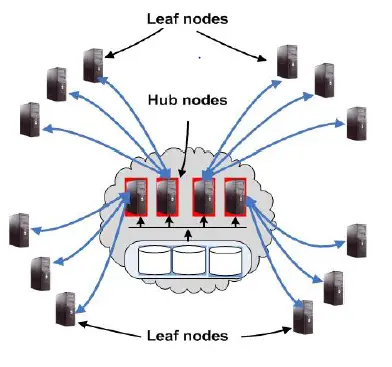With 12c, Oracle has introduced Oracle Flex cluster.Oracle Flex cluster 12c is a new Oracle Clusterware based High Availability clustering topology
It Utilizes two types of cluster nodes:
| Hub nodes | Traditional nodes, tightly coupled via network and storage, used for running IO intensive workload Leaf nodes |
| Leaf Nodes | A new type of node that runs a lighter weight stack Maintain their own failure and heartbeat settings Do not require direct shared storage connectivity Used for processing oriented (application) workload |
So Oracle 12c installation comes with two node , standard Mode and flex cluster mode
Standard mode is same as pre 12c cluster , Flex cluster mode is the new mode with Hub and Leaf Nodes

What are Hub Nodes
1) These nodes are essentially same as conventional nodes in Pre-12c clusters and form the core of the cluster.
2) Each Hub Node is connected with other Hub Nodes via private network for peer-to-peer communication.
3) Each Hub Node can access the shared storage and hence the OCR and voting disks lying on the shared storage.
4) A Hub Node may host an Oracle ASM instance, database instance(s) and applications.
5) Each cluster must have at least one Hub Node and can have up to 64 Hub Nodes.
What are Leaf Nodes
1) They are more loosely coupled to the cluster than the Hub nodes
2) They automatically discover the hub nodes at startup
3) They connect to the cluster through a Hub Node and does not require access to OCR and Voting disk
4) Failure of the Hub Node or network failure results in fail over of leaf nodes to another hub nodes
5) They do not require access to shared storage
6) They runs on the same network as the Hub Nodes
7)They run a lightweight version of the Clusterware.
8) They cannot host database or ASM instances.
9) Leaf Nodes can host different types of applications for example weblogic, EBS, IDM, etc. The applications on Leaf Nodes can failover to a different node if the Leaf Node fails.
10) There may be zero or more Leaf Nodes in a flex cluster.
How leaf Nodes connect to Oracle flex cluster 12c?
When Clusterware is started on a Leaf Node, the Leaf Node automatically uses GNS to discover the Hub Nodes and gets connected to the cluster through one of the Hub Nodes. One Hub node may be associated with zero or more Leaf Nodes. The Hub Node periodically exchanges heartbeat messages with the associated Leaf Nodes, so that Leaf Nodes can participate in the cluster.
How to convert standard cluster to Flex cluster?
1) First check the cluster mode using crsctl
$crsctl get cluster mode status Cluster is running in "flex" mode
2) Run the following command to ensure that the Grid Naming Service (GNS) is configured with a fixed VIP:
$ srvctl config gns
This procedure cannot succeed unless GNS is configured with a fixed VIP. If there is no GNS, then, as root, create one, as follows:
srvctl add gns –i <fixed GNS VIP address> -d <cluster domain>
Run the following command as root to start GNS:
# srvctl start gns
3) Enable Flex ASM in the cluster using ASMCA as Flex cluster mandatory requires Flex ASM
4) Change the cluster mode
#crsctl set cluster mode flex # crsctl stop crs( All nodes) # crsctl start crs( All nodes)
How to change the node role
1.Run the following command to determine the current role of the local node:
$ crsctl get node role config
2.Run the following command as root to change the role of the local node:
# crsctl set node role {hub | leaf}
We will require to configure Oracle ASM and VIP accordingly to roles changes
It is not supported to convert flex cluster into standard cluster.
Some useful command
1)Showing the current node roles
# crsctl get node role status -all Node 'server1' active role is 'hub' Node 'server2' active role is 'hub' Node 'server3' active role is 'Leaf' Node 'server4' active role is 'leaf'
2) To get the node role status
#crsctl get node role status Node 'server1' active role is 'hub'
Benefits of Flex cluster
1) Normal cluster requires peer to peer to communication/interaction between each nodes. So for a 12 node ,normal cluster, we need 66 interactions path
but in case of flex cluster, the peer to peer to communication/interaction is required between hub nodes only and leaf node communicate through hub nodes
So flex cluster makes its more scalable
2) Leaf nodes does not require access to shared storage,so less contention on them
Related Articles
Top Oracle 12c New Features for developers
Useful Oracle 12c pluggable database commands
Flashback PDB in Oracle Database 12c Release 2
Oracle Database Interactive Quick Reference Guide | 11g & 12c